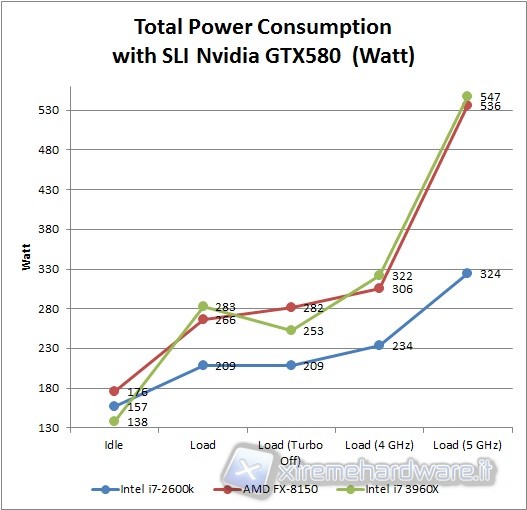Pagina 19 di 22
Consumption Scaling
Continuing with the analysis of scaling, this time we decided to monitor the consumption of the entire system at various frequencies. All CPUs have been tested at default with both active turbo and with turbo off. Then we set an operating frequency of 4 GHz on all cores by turning off the turbo. At this frequency we did not need any kind of overvolt and then was left on default vcore. Finally we got the operating frequency up to well 5 GHz by assigning a voltage of 1.48v, which is necessary for the system to complete at least 10 full cycles of the Lynx stress test.
All consumption measurements were made by Lynx go running for at least 10 complete cycles. The comparison was made with another Intel CPU, the i7-2600K, with 4 cores and 8 threads and compatible with socket LGA 1155.The second CPU is an AMD FX-8150 with 8 cores.
For the i7-2600K up to 4 GHz, it was not necessary to any kind of vcore overvolt, same thing was also valid for the AMD FX. Increasing the frequency to 5 GHz, our i7-2600K has needed well 1.60v (unfortunately this is an unfortunate example), while the AMD FX-8150 has required 1.52v.
The consumption of the systems, equipped with an SLI of GTX 580, were measured upstream the power supply with an high-precision current clamp. Finally, remember that Lynx is one of the heaviest stress test programs in circulation today, and it is a situation that can hardly be repeated in a desktop environment.
Below you can see the graph generated by our findings:

At idle we measured the smallest consumption for the Intel i7-3960X solution with only 138W, followed by 20W spacing each other are the other two CPUs. Looking at the load situation at default CPU and active turbo we can see the power consumption very close to each other between the 3960X and FX-8150; the first has a consumption of 283W while the second 266W, the Intel i7-2600K CPU is rather more distanced with 209W.
Turning off the turbo for all CPUs, we note that for the FX-8150 consumption are increased (quite abnormal behavior), while for Intel CPU consumption go down slightly or remain the same as in the case of 2600K. The reason for this increase on the FX-8150 may be related to the TDP management system, built-in with turbo that could automatically turn off some tricks to limit consumption of Bulldozer architecture.
Bringing the frequency to 4 GHz, which we recall has not requested an increase of operating voltage for any CPU, we can observe that even in this case the consumption recorded by the AMD FX-8150 are very close to Intel i7-3960x with a minimum difference. In this case, the i7-2600K CPU shows a consumption of less than the other two with a gap of about 50W.
Further increasing the frequency and pushing up to 5 GHz, overvolt is required for all CPUs. For the FX-8150 the vcore was equal to 1.52v; for the i7-2600K CPU voltage of 1.6V and finally for the i7-3960X CPU voltage of 1.48v. Again we see how the two top range CPU of the manufacturers are marking their consumption very similar and this time the i7-2600K, despite the high vcore, does mark a radical departure from the other with a difference of more than 200W.
We conclude that the efficiency of Intel, even with the model i7-3960X confirms what has already been seen in performance. We have a good efficiency in relation to its excellent performance. The overclocking instead shows a very high consumption, which entails the adoption of adequate cooling, but also a very strong power supply. As we have pointed out in reviews of x79 motherboards, the little space available for the power supply section of the CPU requires a high efficiency and an adequate cooling for the mosfets.
Turning off the turbo for all CPUs, we note that for the FX-8150 consumption are increased (quite abnormal behavior), while for Intel CPU consumption go down slightly or remain the same as in the case of 2600K. The reason for this increase on the FX-8150 may be related to the TDP management system, built-in with turbo that could automatically turn off some tricks to limit consumption of Bulldozer architecture.
Bringing the frequency to 4 GHz, which we recall has not requested an increase of operating voltage for any CPU, we can observe that even in this case the consumption recorded by the AMD FX-8150 are very close to Intel i7-3960x with a minimum difference. In this case, the i7-2600K CPU shows a consumption of less than the other two with a gap of about 50W.
Further increasing the frequency and pushing up to 5 GHz, overvolt is required for all CPUs. For the FX-8150 the vcore was equal to 1.52v; for the i7-2600K CPU voltage of 1.6V and finally for the i7-3960X CPU voltage of 1.48v. Again we see how the two top range CPU of the manufacturers are marking their consumption very similar and this time the i7-2600K, despite the high vcore, does mark a radical departure from the other with a difference of more than 200W.
We conclude that the efficiency of Intel, even with the model i7-3960X confirms what has already been seen in performance. We have a good efficiency in relation to its excellent performance. The overclocking instead shows a very high consumption, which entails the adoption of adequate cooling, but also a very strong power supply. As we have pointed out in reviews of x79 motherboards, the little space available for the power supply section of the CPU requires a high efficiency and an adequate cooling for the mosfets.

